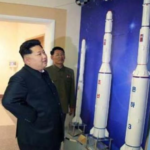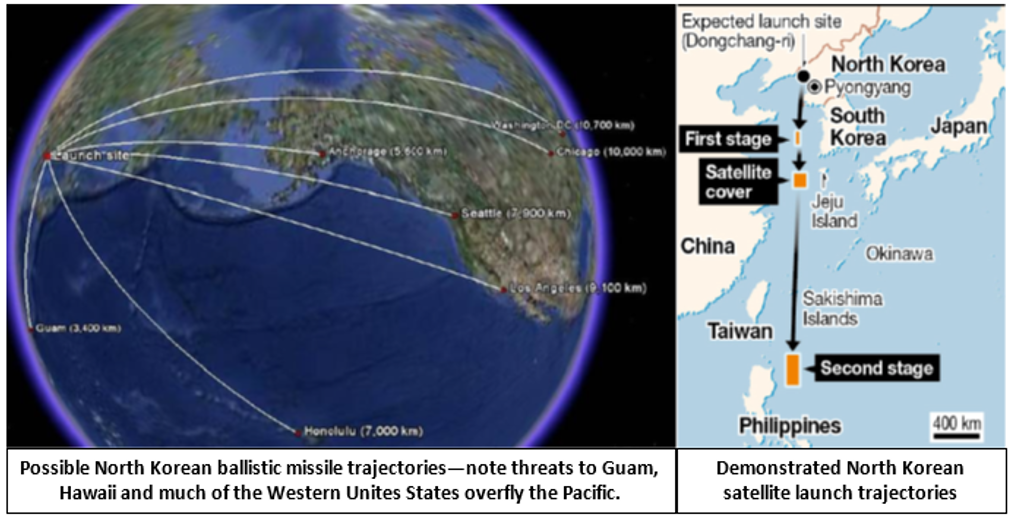“U.S. missile defenses against North Korea are not postured to shoot down North Korean missile tests . . . Shooting down North Korean missiles that fall within the defended areas of these systems, such as the Japanese and U.S. homelands, would be challenging enough.”~ Kingston Reif, director of Disarmament and Threat Reduction policy at the Arms Control Association On Fox News, September 18, 2017 . . . If so, shame on us!
This quotation is from September 19 Fox News article titled “Can U.S. military shoot down a North Korean ballistic missile?” Click here for the full article by Katherine Lam that, like many other articles before and since, does not answer this fair question — at least to my satisfaction.
I believe we have inherently effective ballistic missile defense (BMD) systems, provided the crews are operationally trained and authorized to achieve timely intercepts.
In any case, the American people deserve authoritative, accurate answers to Lam’s question, because in the past few months North Korea has demonstrated by highly publicized testing a potential if not already existing capability to deliver nuclear weapons (likely Hydrogen, or H-Bombs) via ballistic missiles that already threaten U.S. troops in South Korea and Japan and other nearby territories, including Guam — as well as Hawaii and possibly all the rest of the United States.
Moreover on the eve of President Trump’s 13 day to persuade North Korea’s neighbors to join us in blocking North Korea’s declared trek to gain nuclear armed ballistic missiles, White House Chief of Staff Retired Marine General John Kelly acknowledged on Fox News on October 31, 2017 that he is concerned about such ballistic missiles delivering an electromagnetic pulse (EMP) that could kill up to 90-percent of all Americans.
Click here for that full 22-minute interview. Note: North Korea has claimed such an EMP attack capability is among its “strategic goals.”
This is very serious business, especially when one understands that the North Korean low yield tests could have included “Super EMP” weapons, based on design information passed to North Korea by Russian scientists and engineers in the late 1990s. The EMP Commission has formally and publically warned about these conditions since 2004. Yet, these warnings have been unheeded by the Washington “Powers that Be.”
Click here for October 12, 2017 comprehensive testimony to the Oversight and Oversight and Management Efficiency Subcommittee of the House Homeland Security Committee on the related issues by the EMP Commission’s Chairman Dr. William R. Graham and its Chief of Staff Dr. Peter Vincent Pry, and click here for their related October 22, 2017, Washington Times article, emphasizing “How the electric grid has been compromised,” in a way that well illustrates the federal government inefficiency — and that’s a generous description of its malfeasance — in dealing with this truly existential threat.
Their testimony not only once again confirms the seriousness of the existential EMP threat — as the EMP Commission warned in its 2004 and 2008 reports — and the fact that we should harden our critical civil infrastructure against this threat is well known.
They also noted the lack of wisdom in permitting the EMP Commission to end on September 30, and recommended “strengthening U.S. ballistic missile defenses — including deployment of space-based defenses considered by the Strategic Defense Initiative — and that these be designed and postured to also protect the U.S. from EMP attack.”
And I say Amen to that!
But we are not starting from scratch, even though some press accounts are not well informed, as illustrated by the above comments by Kingston Reif — and there are others who share his misinformed view. I trust that the press simply does not understand what our current defenses can do today, if our missile defense crews are:
- Trained to use the inherent capabilities of the defenses we have deployed; and
- Prepared and authorized to intercept attacking ballistic missiles in a timely way.
Consider the attacking ballistic missile threat trajectories illustrated below.
On the left are nominal ballistic missile trajectories of various ranges that could reach U.S. territory in Guam, the state of Hawaii and various U.S. cities all the way to our east coast. Most of them fly over water for at least a portion of their trajectory, and potentially can be intercepted by our Aegis BMD ships depending on where they are located and whether their crews are properly trained, operationally ready and duly authorized to intercept those targets.
And of course our ground-based interceptor sites in Alaska and California are prepared to intercept a few ballistic missiles that may threaten the continental U.S. homeland from over the North Polar region.
On the right is a typical trajectory of a North Korean satellite launch, directed southward over the South Polar regions to approach the United States from our poorly protected south. Depending on the location of our Aegis BMD ships they should have several shot opportunities before the attacking North Korean satellite launcher exceeds the defenses range capability — again provided the crews are trained, ready and authorized to engage in a timely way.
This defense could be improved with additional radar tracking capabilities in the Philippines — a potential subject for President Trump’s stop in a few days. The THAAD TPY-2 radar could add significant tracking information to aid our four ground based interceptors on Vandenberg AFB in California.
Beyond these potential capabilities, we could also rapidly deploy a capability to shoot down North Korean ballistic missiles in their boost phase, while their rockets still burn and they are very vulnerable — up to the second stage burnout in the figure on the right.
I previously discussed how this this highly desirable capability can be rapidly obtained. Click here for my October 3, 2017 message with included links to my Newsmax articles elaborating how we can modify the existing capabilities of our Air Force and Navy fighters to employ our AMRAAM interceptors for this purpose until we can obtain dedicated High Altitude Long Enduring (HALE) unmanned aircraft — or drones — to more economically maintain a full-time airborne boost phase intercept capability.
In any case, my opinion is that the best answer to the question about our ability to shoot down North Korean ballistic missiles is, “It depends on how our leaders have prepared to counter the threat.” And today, I worry that we have not prepared as much as we should.
We certainly have ways to provide that capability, and I hope that we have done so. But hope is not a strategy — and I trust our military leaders have taken proper precautions. And we should be planning to improve the defenses we have.
Then there’s the problem of dealing with the EMP threat if our defenses fail, and as I have repeatedly discussed we are unprepared. No defense is perfect.
Click here for my September 26, 2017 message in which I agreed with the Commander of U.S Strategic Command (STRATCOM) General John Hyten that we clearly have lost our way, and our nation’s survival depends on our again becoming innovative. He was speaking of how long it takes today to build truly effective systems. Protecting against the EMP threat is such a challenge that we need to solve quickly.
Indeed, he called EMP “a very dangerous threat” to which we must be able to respond. He reported that STRATCOM assets were hardened against the EMP threat, but also correctly observed that our critical civil infrastructure, upon which the nation’s very survival depends, is not.
While he did not so state, the reason for that shortcoming is that Department of Defense (DoD) authorities do not consider protecting our critical civil infrastructure to be their business. A previous Commander of Northern Command (NORTHCOM) noted several years ago that assuring the viability of the nation’s critical civil infrastructure was not his job. He said his job was to support the Department of Homeland Security (DHS) and the FBI in accomplishing their mission of protecting the nation from terrorism.
And guess what? To my best understanding, DHS is still not leading to accomplish this important job, especially when it comes to the EMP threat to the nation’s electric power grid! There are several thousand utility companies and CoOps that are involved in delivering needed electricity to the American people through a network of generation, distribution and transmission infrastructure. We need much clearer thinking and working plans to make this critical infrastructure viable.
As I testified before the Senate Energy and Natural Resources Committee on May 4, 2017, the Federal Government is dysfunctional; so repairing this situation will require serious involvement of local and state authorities to assure that this issue is dealt with anytime soon. Click here and here for my May 9 and 16 discussion of this issue and links to my testimony and of the entire hearing, including important testimony by former House Speaker Newt Gingrich.
Moreover, Congress now threatens to add to our problems by not renewing the current EMP Commission, with its original charter.
Whatever congress does, President Trump should issue an Executive Order establishing a body (invent a new name), including as many of the EMP Commissioners who wish to continue serving in a White House office with direct access to the President and with a charter and resources to oversee a top priority renovation of the current disaggregated and dysfunctional federal establishment that is failing to protect the American people against the catastrophic loss of the electric power grid from the full complement of threats, including EMP.
Bottom Lines.
Our leaders should be making our ballistic missile defenses “all they can be” — including by reviving the space based defenses pioneered by Ronald Reagan’s Strategic Defense Initiative (SDI) and scuttled by the Clinton administration to remain dormant ever since. STRATCOM Commander Hyten is an excellent choice to champion this objective.
Thus, I stand with the EMP Commission in arguing for “strengthening U.S. ballistic missile defenses — including deployment of space-based defenses considered by the Strategic Defense Initiative — and that these be designed and postured to also protect the U.S. from EMP attack.”
Hopefully, President Trump’s trip to Asia will help pave the way for this possibility.
And when he returns, he should issue an Executive Order establishing a White House office, reporting to him, to assure that the electric power grid is viable against the full complement of threats, and particularly the existential EMP threat.
Stay tuned . . .
What can you do?
Join us in praying for our nation, and for a rebirth of the freedom sought, achieved and passed to us by those who came before us.
Help us to spread our message to the grass roots and to encourage all “powers that be” to provide for the common defense as they are sworn to do.
Begin by passing this message to your friends and suggest they visit our webpage www.highfrontier.org, for more information. Also, please encourage your sphere of influence to sign up for our weekly e-newsletter.
Encourage them to review our past email messages, posted on www.highfrontier.org, to learn about many details related to the existential manmade and natural EMP threats and how we can protect America against them. I hope you will help us with our urgently needed efforts, which I will be discussing in future messages.
Click here to make a tax deductible gift. If you prefer to mail a check, Please send it to 500 North Washington Street, Alexandria, VA 22314.
E-Mail Message 171107
Please click here to read Past Weekly Updates!
Please help High Frontier continue this important and timely work!
Be sure to follow us on our Social Sites!
If you found this letter via our Social Sites, and you would like to subscribe, please click below!







